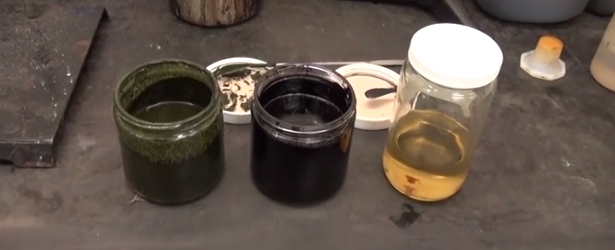Turning algae into crude oil in less than an hour

It is known that algae-based biofuel most closely resembles the composition of the crude oil that gets pumped out from beneath the sea bed but now, researchers at the U.S. Department of Energy's Pacific Northwest National Laboratory in Richland, Washington, have discovered a way to speed up this "cooking" process to the point where a small mixture of algae and water can be turned into a kind of crude oil in less than an hour.
Besides being readily able to be refined into burnable gases like jet fuel, gasoline or diesel, the proprietary technology also generates, as a byproduct, chemical elements and minerals that can be used to produce electricity, natural gas and even fertilizer to, perhaps, grow even more algae.

"When it comes down to it, Americans aren't like Europeans who tend to care more about reducing their carbon footprint," says lead investigator Douglas C. Elliott, who's researched alternative fuels for 40 years. "The driving force for adopting any kind of fuel is ultimately whether it's as cheap as the gasoline we're using now."
Scientists have long been intrigued by the laundry list of inherent advantages algae boasts over other energy sources. The U.S. Department of Energy, for instance, estimates that scaling up algae fuel production to meet the country's day-to-day oil consumption would take up about 15,000 square miles of land, roughly the size of a small state like Maryland. In comparison, replacing just the supply of diesel produced with bio-diesel from soybeans would require setting aside half of the nation's land mass.
Besides the potential for much higher yields, algae fuel is still cleaner than petroleum, as the marine plants devour carbon dioxide from the atmosphere.
Agriculturally, algae flourishes in a a wide range of habitats, from ocean territories to wastewater environment. It isn't hazardous like nuclear fuel, and it is biodegradable, unlike solar panels and other mechanical interventions. It also doesn't compete with food supplies and, again, is similar enough to petrol that it can be refined just the same using existing facilities.
The promise of oil from algae was tantalizing enough that ExxonMobil, in 2009, enlisted the expertise of world renowned bioengineer Craig Venter's Synthetic Genomics lab to fabricate a genetic strain of lipid-rich algae, as a means to offset the expense of cultivating and processing the substance into a commercially attractive resource. Yet, despite investing $600 million into a considerably ambitious endeavor, the project was beset with "technical limitations," forcing the company to concede earlier this year that algae fuel is “probably further” than 25 years away from becoming mainstream.
The hydrothermal liquefaction system that Elliott's team developed isn't anything new. In fact, scientists tinkered with the technology amid an energy crisis during the 1970s as a way to gasify various forms of biomass like wood, eventually abandoning it a decade later as the price of gasoline returned to more reasonable levels. PNNL's lab-built version is, however, "relatively newer," and designed simply to demonstrate how replacing cost-intensive practices like drying the algae before mixing in chemicals with a streamlined approach makes the entire process much more cost-effective across all phases. Elliott explains, for example, that the bulk of the expenditures are spent on raising algae, which is either grown in what’s called an open-pond system, similar to natural environments, or in well-controlled conditions found in closed-loop systems. The open-pond system isn't too expensive to run, but it tends to yield more contaminated and unusable crops while artificial settings, where algae is farmed inside clear closed containers and fed sugar, are pricey to maintain.
"People have this slightly inaccurate idea that you can grow algae anywhere just because they'll find it growing in places like their swimming pool, but harvesting fuel-grade algae on a massive scale is actually very challenging," Elliott says. “The beauty of our system is you can put in just about any kind of algae into it, even mixed strains. You can grow as much as you can, any strain, even lower lipid types and we can turn it into crude."
Elliott's team has licensed the technology to the Utah-based startup Genifuel Corporation, which hopes to build upon the research and eventually implement it in a larger commercialized framework. He suggests that the technology would need to be scaled to convert roughly 608 metric tons of dry algae to crude per day to be financially sustainable.
Source: SmithsonianMag
Featured image: YT video screenshot

When it comes down to it, Americans are in suicidal pursuit of their very own extinction event.